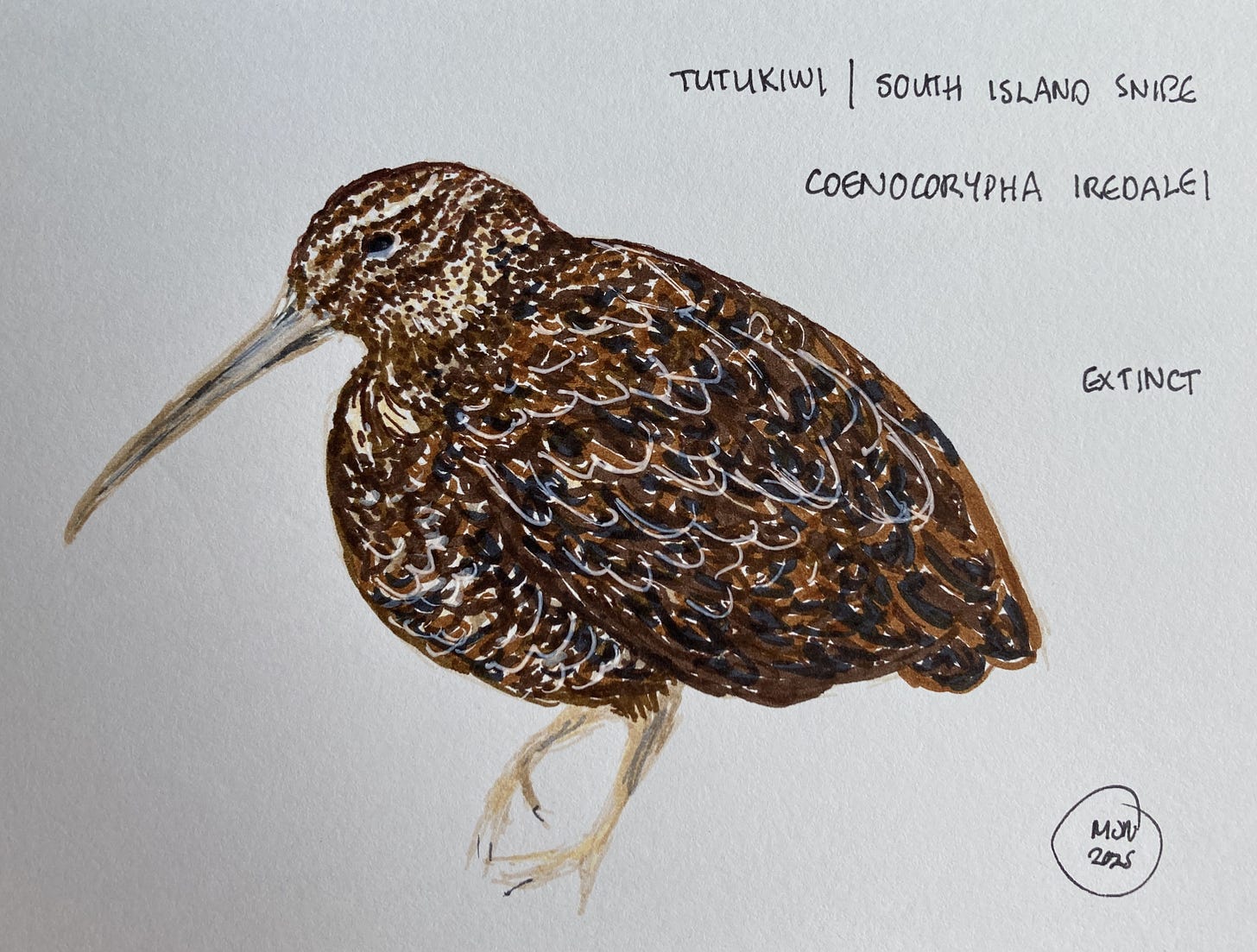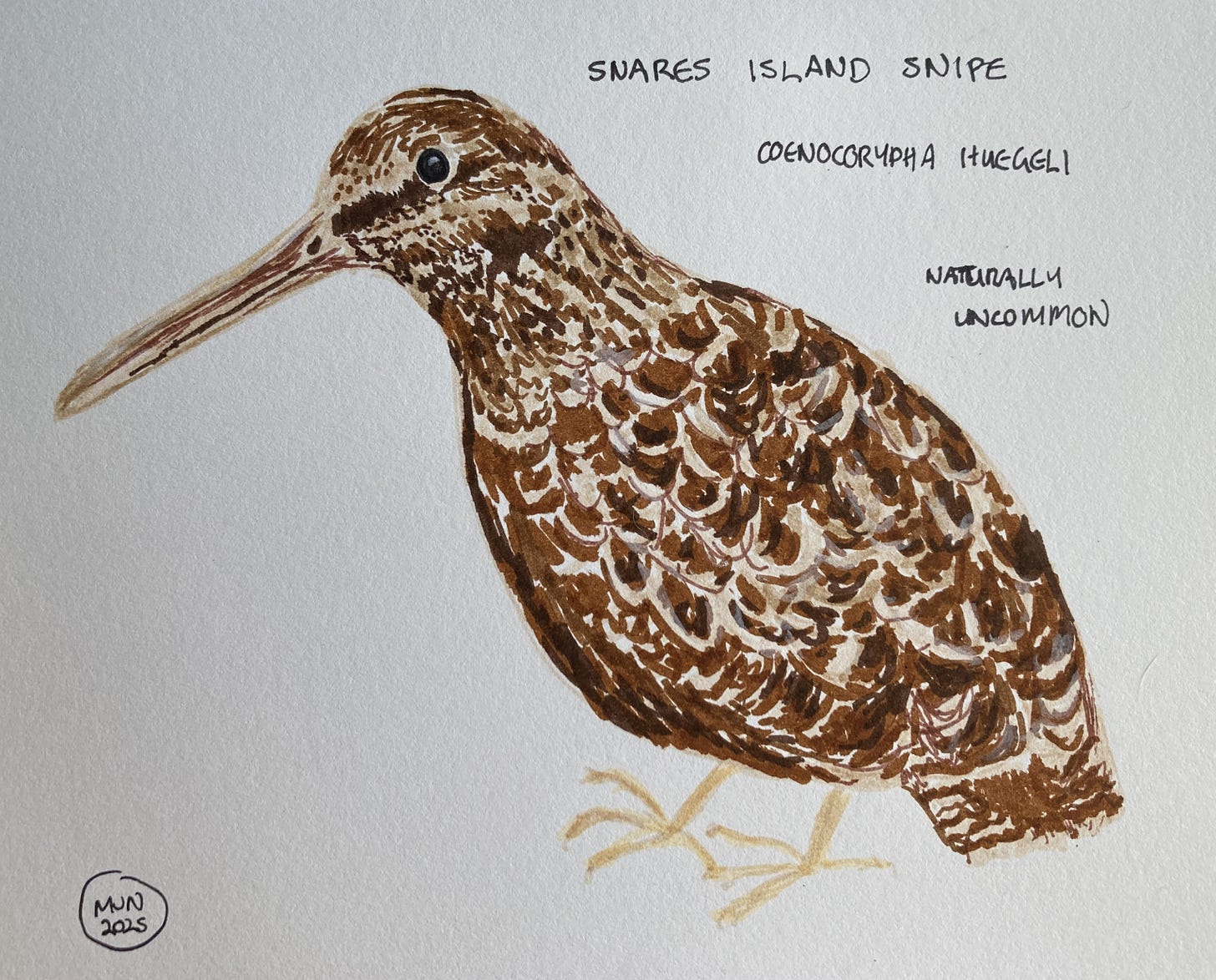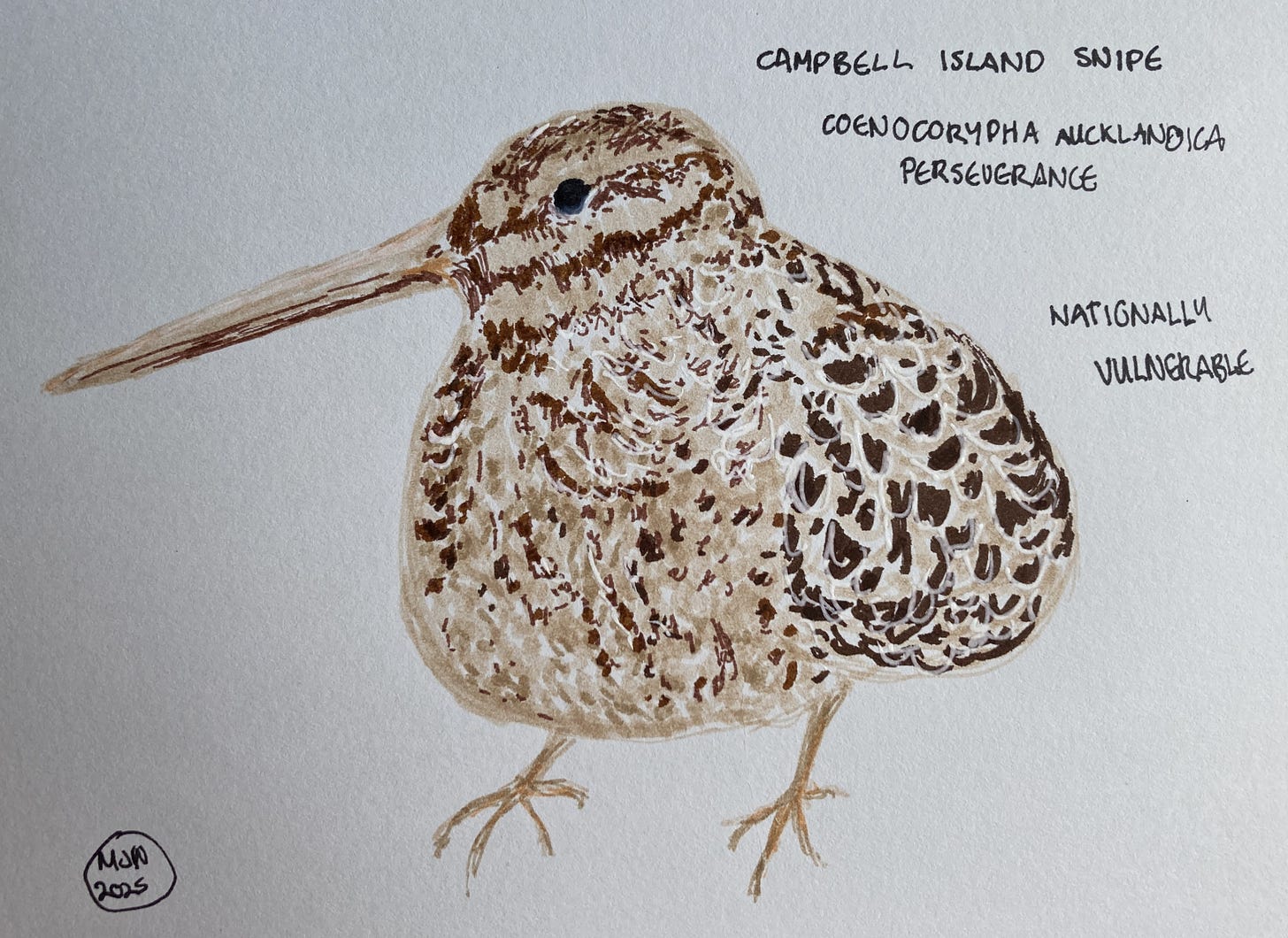A snippet of hope
Tragedy and triumph for some of our most obscure birds (7 minute read)
This week, I’ve had some extra work to do, which means I haven’t finished my planned article about some recent research on climate change impacts. Instead, I’ve decided to share something I’ve been planning for one of my Sunday articles, about some sweet little birds which are cousin to the ruddy turnstone, the bird which gives my newsletter its name.
New Zealand’s seashores are home to dozens of species of shorebird, those which mainly live on coastlines and search for their prey on foot. Among the more conspicuous is the tōrea pango or variable oystercatcher, a large bird with black or black and white feathers, a stout orange beak and pink legs. Another familiar species is the pied stilt, which looks slightly absurd with its disproportionately long legs. Perhaps the most famous is the kuaka or godwit, which makes its epic journey between New Zealand and Alaska twice a year. A few species can be found inland, including the critically endangered kakī or black stilt and the spur-winged plover, which made its own way here from Australia in the early 1900s. Although they may live far from the sea, they still tend to be birds of open areas.
One group of shorebirds, though, followed a different path. Instead of wading through the water of estuaries, probing in the mud for crabs and other small invertebrates, they scuttled around in the dense undergrowth of forests and shrublands.
Overseas, there are a number of different snipe species, but they aren’t quite the same as our snipes. They do look similar, mottled in brown, black and white, with a long beak, but they are classified as a different group. Our species are sometimes known as austral snipes, to indicate their distinct status and southern distribution. They weigh about the same as a tūī, but their body is shorter and rounder. While quite capable of flying, they rarely do so, spending almost all their time on the ground.
Bone deposits tell us that snipe once lived from one end of the country to the other. There was a North Island species and a South Island species, the tutukiwi, which was also found on Rakiura/ Stewart Island. However, as you may have guessed from my use of the past tense, there are no longer snipe from one end of the country to the other. These birds were ill-equipped to cope with introduced predators, and weren’t even able to coexist with kiore. By the time Europeans arrived, the birds had disappeared from all but a few offshore islands. The North Island snipe survived on Te-Hauturu-a-Toi/ Little Barrier until around 1870, and the single specimen collected, which is now in the Auckland museum, remains the only one known.
The tutukiwi lasted longer, surviving until the 1960s on Taukihepa/ Big South Cape Island off the coast of Rakiura. It was one of the three species which became extinct when rats invaded, but even before that it was in trouble, after weka were introduced to the island in the 1920s.
The Chatham Island snipe almost suffered the same fate, but a small number of birds survived on Rangatira and the Star Keys. These birds have been reintroduced, or have reintroduced themselves, to other predator-free islands around the Chathams, and occasionally fly to Pitt Island. They are still a threatened species, but their situation is not as dire as it once was.
Another snipe species, with a longer beak, was described from bones found on both Chatham and Pitt Islands in the late 1800s. There are no reports of anyone seeing it alive, and very little is known about it. It’s not the only snipe known only from bones. Over the last 30 years, scientists have identified that species of austral snipe were also once found on Norfolk Island, Fiji and New Caledonia. However, these birds disappeared with the arrival of humans, or rather the kiore they brought with them.
Far from the mainland, though, the austral snipe has done a little better. South of New Zealand, there are five groups of islands collectively known as the Subantarctic islands1. Two species of snipe survive there, and from these islands comes one of the most remarkable bird discoveries in our recent history – I’ll get to that in a moment.
The Snares Islands, which have never had any introduced mammals, have one snipe species. Since the island group comprises only 340 hectares of land, it’s unlikely that there were ever very many Snares Island snipe. While these islands are almost entirely unmodified by human actions, they remain vulnerable to rat invasion. If a couple of rats arrived, the entire snipe population could be wiped out before anyone noticed. So, in the last 20 years this species has been introduced to some predator-free islands off Rakiura, where tutukiwi once lived. The snipe have done well there, and there may be more of this little bird now than at any time in its history.
Further south are two other island groups, the Auckland Islands and Antipodes Islands, as well as Campbell Island, which stands alone apart from a few tiny islets. As on the mainland, introduced mammals have been a serious problem, and it’s likely that snipe were wiped out on a number of these islands. However, some of the smaller of the Auckland Islands have remained largely free of mammals. The Antipodes Islands escaped the worst of the introduced mammal predators, with only mice ever establishing – these have now been eradicated. Subantarctic snipe, which have a longer beak and legs than the other snipe species, survived on a few of the predator-free Auckland Islands and the Antipodes Islands. Although the birds from the two island groups are similar, they aren’t quite the same. They are considered to be two different subspecies of the Subantarctic snipe.
If snipe had been present on Campbell Island, it was assumed that they must have been long-extinct, since Norway rats were well-established before the first scientific expedition to the island in 1840. By the late 20th century, the island had the highest Norway rat densities seen anywhere in the world. However, in 1997 scientists with tracker dogs visited Jacquemart Island, a kilometre south of Campbell Island and less than 20 hectares in size. They hoped to find another population of the endangered Campbell Island teal. They found no teal, but the dogs flushed a snipe from the undergrowth, the first time a snipe had ever been seen on Campbell or nearby islands.
Jacquemart Island is supremely inaccessible, and the scientists had three hours there. In that time, they saw only one other bird, which they managed to catch and photograph (and release). It was similar to the snipe on the Auckland and Antipodes Islands, but not quite the same. While the dogs indicated that there were other birds present, the situation of these birds was extraordinarily precarious. They had survived only on that tiny scrap of land for more than 180 years.
But everything was about to change. In 2001, the Department of Conservation attempted the largest ever rat eradication, dropping tonnes of toxic bait on Campbell Island. To call the project ambitious would be an understatement – Campbell was six times larger than any other island where rats had been successfully eradicated, and it was 700 kilometres south of New Zealand in the world’s wildest ocean. The crew were on the island for six weeks, and then they left, hoping that their bold experiment would work.
When they returned two years later, it was a different island. With the island no longer overrun by rats, when the crew went out at night, they found wētā everywhere. During the day, the calls of pipits cut through the sound of the ever-present wind. And on the muddy shore of Six Foot Lake, they found footprints. They didn’t match any bird known to be on Campbell Island, but they were consistent with the snipe found on Jaquemart Island a few years previously. Had the birds reintroduced themselves once the rats had gone?
It would be another two years before their suspicions were confirmed. On a 2005 visit, scientists were able to catch one bird, which turned out to be a juvenile snipe2, proving that the birds were not only present, but breeding on Campbell Island. The moment that the rats were gone, the snipe were back. A few years later, the birds were formally identified as a different subspecies of Subantarctic snipe from those in the Auckland and Antipodes Islands.
Over the last hundred years, we have had some dramatic rediscoveries of birds thought to be extinct, but I think that the discovery of the Campbell Island snipe tops them all. Until those two birds were spotted on Jaquemart Jacquemart Island, we never even knew they existed. We came so close to never knowing about them at all, but when we gave them a chance, they showed us how resilient they really are.
I’ve never been to any of the Subantarctics, and suspect I never will, given how badly seasick I get. But I may write about them one day anyway, because they are wonderful, special places.
One article by austral snipe expert Colin Miskelly describes chicks and juvenile snipe as snippets. I can’t find any evidence that this is the official term, but it’s certainly an appealing idea.






I vote for snippets too. Nice one Colin.
An interesting post! About one year ago our resident stray cat gave up trapping and killing birds in our backyard hedge. Now we have a small guano issue which does not detract from watching territorial Blackbird males dogfighting in mid air and modern day sparrows copying piwakawaka acrobatic flight patterns as they pursue small moths.
One thing I feel obliged to note is the tauhou silver eye who is also as the name indicates a recent arrival. And given the fact birds do not recognize political borders it occurs to me, as an aside, that Kiwi voters might support re-unification with Australia, which has a bigger budget for protecting our feathered friends.
Thanks for sharing